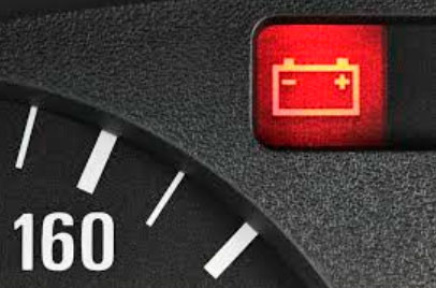
When the battery discharge warning appears on your car screen, infotainment system, or info cluster, it's your vehicle's way of telling you something's amiss with the charging system. It's an alert that your car's battery is losing charge faster than it can replenish itself. In other words, your battery is on the brink of exhaustion, and if left unaddressed, it could lead to a complete electrical failure.
Several factors could contribute to this predicament, and we will look into the most common causes. Remember, the battery discharge warning is not to be taken lightly. It serves as an early warning system, alerting you to potential electrical failures looming. By promptly addressing the issue and seeking professional assistance, you can ensure that your car remains a reliable companion for many miles to come.

TOP 3 Causes of Battery Discharge
There is always something wrong when you see this warning signal pop up. And some issues are more common than others, so let’s focus on them for now.
Bad Alternator

One common culprit is a faulty alternator. The alternator plays a vital role in generating electricity while the engine is running, recharging the battery and powering various electrical components. If the alternator is on the fritz, it won't be able to fulfil its duty, causing the battery to drain gradually.
Signs like dimming or flickering headlights, electrical malfunctions, and strange noises from the engine compartment can hint at this problem. Check the alternator belt tension and connections to ensure they are in good condition. Loose or damaged belts can affect the alternator's performance. If you've determined a faulty alternator, seek professional assistance or replace it if you're skilled. Consult your vehicle's service manual for instructions, or visit a trusted mechanic or service centre.
Parasitic Draw

Another potential cause is a parasitic draw. This refers to an electrical component or system that continues to consume power even when the vehicle is turned off. It could be a malfunctioning interior light, a faulty radio, or a pesky vampire drain somewhere in the electrical system. Identifying and rectifying such power-hungry culprits is crucial to resolving the battery discharge warning issue.
Faulty Charging System

When your vehicle's charging system malfunctions, it fails to replenish the battery's charge adequately, leading to a drain in power. As a result, the battery discharge warning alert may be triggered.
The charging system comprises various components, including the alternator, voltage regulator, and battery itself. If any of these components experience issues, the charging system's efficiency is compromised.
It is important to address a faulty charging system promptly. A comprehensive diagnostic evaluation by a qualified mechanic or automotive professional is recommended. They will assess the condition of the alternator, voltage regulator, and associated wiring to identify the specific cause of the malfunction.
Can You Fix a Dead Battery?
One of the most common methods to breathe life back into a discharged battery is jump-starting. It's like giving your battery a jolt of adrenaline to get it going again. Here's how you can do it:
-
Find a Good Samaritan with a functioning vehicle and jumper cables.
-
Park the two vehicles close enough for the jumper cables to reach both batteries.
-
Turn off the ignition in both vehicles and ensure all electrical components are switched off.
-
Connect the positive (red) clamp of the jumper cables to the positive terminal of the dead battery.
-
Connect the other end of the positive (red) clamp to the positive terminal of the working battery.
-
Connect the negative (black) clamp of the jumper cables to the negative terminal of the working battery.
-
Here comes the tricky part. Instead of connecting the negative (black) clamp to the negative terminal of the dead battery, attach it to an unpainted metal surface or an engine ground point in the dead vehicle. This helps prevent sparks or potential hazards.
-
Start the engine of the functioning vehicle and let it run for a few minutes.
-
Attempt to start your car with the discharged battery. If successful, let both vehicles idle for a while to allow the discharged battery to recharge.
-
Disconnect the jumper cables in the reverse order of attachment.
Jump-starting provides a temporary solution to get you back on the road, but don't overlook the importance of battery reconditioning and maintenance for long-term reliability. Remember, a battery discharge warning is your vehicle's cry for help. By understanding the warning signs, taking proactive measures, and seeking professional assistance when needed, you can conquer the battery discharge warning and keep your automotive adventures running smoothly.
Can You Drive with a Discharged Battery?
Driving with a discharged battery is a risky game that's best left unplayed. The battery discharge warning is your vehicle's way of saying, "Hey, take care of me!" Ignoring it can lead to electrical system failures, being stranded in inconvenient locations, and further damage to the battery itself.
When faced with a dead battery, consider jump-starting as a temporary fix or seek professional assistance to recharge or replace the battery. Remember, a healthy battery ensures a smooth and enjoyable driving experience devoid of unwelcome surprises. So, heed the battery discharge warning and take care of it.
How Long Will a Battery Discharge?

The duration of a battery discharge depends on various factors, including battery condition, ambient temperatures, and usage patterns. However, if you know you won't be using your car for an extended period or won't have the opportunity to recharge the battery regularly, there are steps you can take to preserve its lifespan.
Also, when faced with extended periods of inactivity or limited opportunities for recharging, understanding the duration of a battery discharge becomes crucial. By disconnecting the battery from the vehicle and storing it properly in a suitable location, you can prolong its charge and preserve its lifespan for up to six months.
How Many Times Can a Battery Be Discharged Before It Goes Bad?
The lifespan of an auto battery is measured in terms of charging cycles. A charging cycle refers to the process of discharging the battery to start the vehicle and then recharging it to its full capacity. Each cycle contributes to the overall lifespan of the battery.
Most auto batteries can endure between 500 and 1,000 charging cycles before they start to degrade significantly. Discharging them and leaving without due maintenance can decrease this amount, but it’s all really unpredictable. The exact number of cycles may vary depending on various factors like your driving style, battery quality and even climate.
Should I Be Worried About the Battery Discharge Warning?
The battery discharge warning serves as a safeguard against situations where the battery could be drained unintentionally. For instance, if you're playing the car radio or using other accessories while the engine is off, the warning will alert you that continuing to draw power will eventually result in a depleted battery.
This warning light can also indicate underlying issues with the charging system or the battery itself. If the warning light persists even when you're not actively using power-consuming devices, it could suggest a more serious problem.
By addressing the warning promptly, you can avoid the inconvenience of a dead battery and potentially prevent more severe charging system complications. So, pay attention to the battery discharge warning and respond accordingly to ensure a reliable and hassle-free driving experience.
Same articles

Understanding Vehicle Inspection and Verification Services: Why They Matter for Every Driver
GuidesVehicle inspection and verification services are an essential but often overlooked part of keeping roads safe and cars legally compliant. Most people only think about inspections when it’s...

Anonymous Cryptocurrency Exchange: Unlocking Confidential, Flexible Crypto Trading in 2025
GuidesThe concept of an "anonymous cryptocurrency exchange" has become a focal point in the digital asset world as privacy, user autonomy, and security have...

Renting a Car: What Do You Need to Know
GuidesEmbarking on the journey of renting a car for the first time can be akin to navigating uncharted waters. It's a path many have traversed, driven by the need for convenience, exploration, or...

